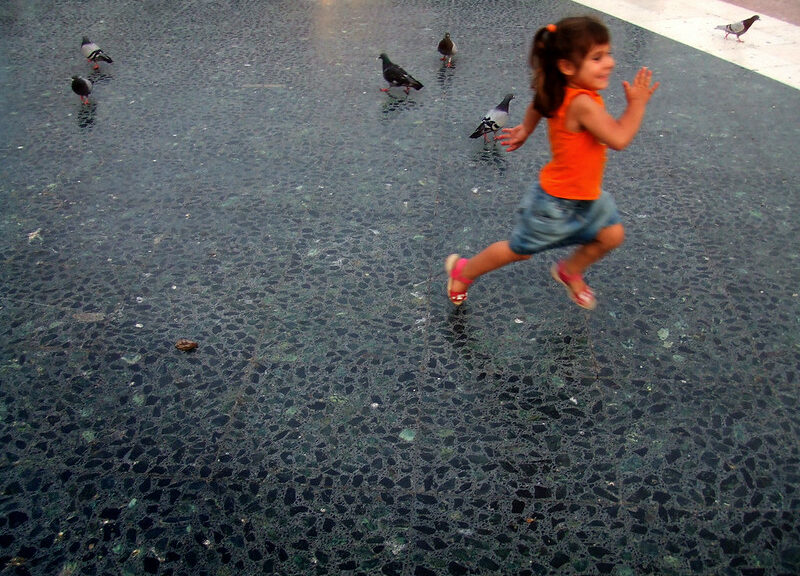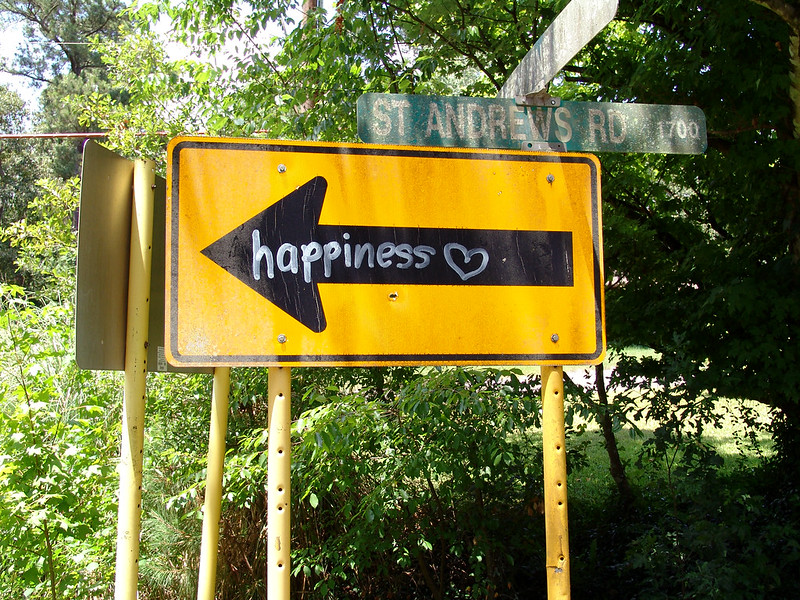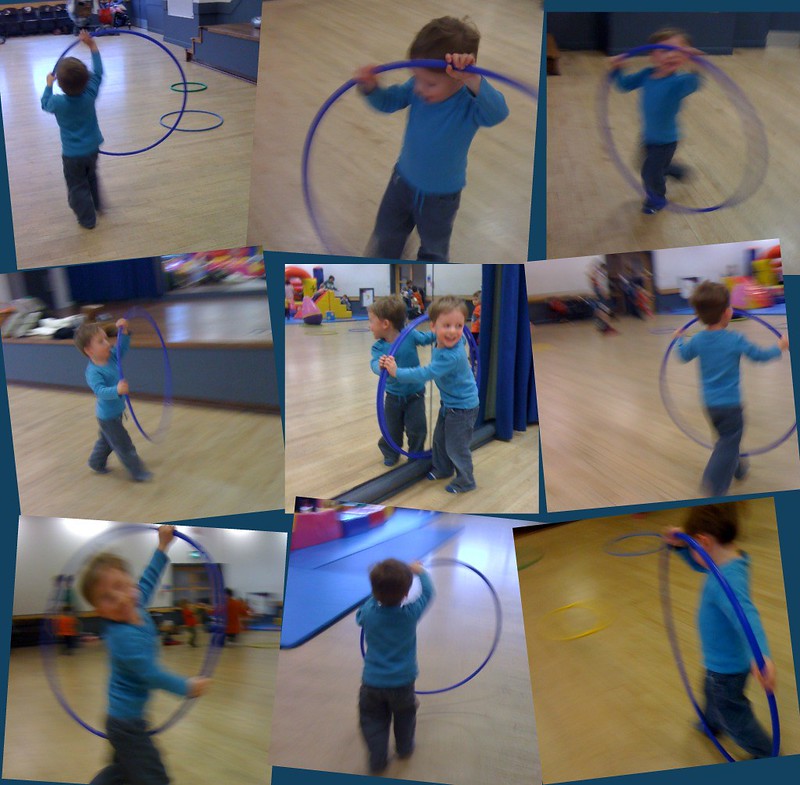
HAPPINESS IS A SIDE-EFFECT
Throughout the ages humans have gnawed on the conundrum of getting to “happy.” We know we want it. We’ll do a lot to get there, we say, as we set up and set out on some course of action or other to “pursue” our own kind of happy.
There are whole libraries of wisdom-words from past generations of sages and wise guys, from the research and cogitations of scientists and other smarty-pants over the past half a century, as well as from the everyday musings and head-scratchings of the man (or woman)-on-the-street that we can tap.
Everybody agrees. Happy is better for us humans – physically, mentally, and spiritually — than not-happy.


- Do we run towards or after happy? Or do we sit there and wait for it to land on us?
- Is happy inside us? Or does it come to us as a gift from the World, the Universe, the Divine or something other than ourselves?
- Can someone else make us happy? Or is it a D.I.Y. project?
ARGH!
THE TROUBLE WITH LOOKING FOR HAPPINESS OUTSIDE OURSELVES
It seems to me that the problem with the whole “pursuit” thing and with seeing happiness as an end-goal or even as something that is outside our own selves is addressed in this extraordinary YouTube video, “Happiness,” uploaded in 2917 by Steve Cutts:
Ouch! That one sure feels familiar, doesn’t it?
If the Big Happy is not in us, then we are likely to be in for a really rough struggle getting to our “happy place” and the odds aren’t looking so good for us. Recovering-Control-Freak Me has a really hard time accepting that one as a viable, sustainable option.

A HAPPY SYNERGY UNPACKED
In the mid-1990’s a couple of social scientists, Rick Foster and Greg Hicks, began a most intriguing study never before tackled by smarty-pants of their ilk. They wandered around the countryside and then the world asking, “Who is the happiest person you know?”
In every town or village or organization the researchers visited, there was usually some consensus about who the happiest-seeming person was in that place. In the course of their three years of research the pair tracked down hundreds of extremely happy people.

Like all good scientists, the first thing the researchers did was ask the people who did it best to define what “happiness” was.
Here’s the definition they formulated out of all the answers they got:
“…true happiness is a profound, enduring feeling of contentment, capability, and centeredness – the 3 C’s.. It’s a rich sense of well-being that comes from knowing you can deal productively and creatively with all that life offers – both the good and the bad. It’s knowing your internal self and responding to your real needs, rather than the demands of others. And it’s a deep sense of engagement – living in the moment and enjoying life’s bounty.”
That definition feels just about right, it seems to me. It’s sufficiently complex and complicated enough to be real, yet simple enough to get your head around. It’s just ordinary in an extraordinary way.

Happiness, it seems, doesn’t come from any specific circumstance. Happiness begins with each person and the patterns of choices they make that work together to create a kind of synergy, an energy field, that builds up around them and affects how the mega-happy people move and what they do.
It also became evident that how these ultra-happy people move and what they do affect the way they see their worlds. The perspectives they develop as a result of their actions generate (bet you guessed it!) their own brand of happiness.

Integrating the nine choices into the way they lived their lives gave these happy folks lives filled with meaning and mana. The side-effect of that was the feeling of happiness, as defined by those who lived this way.
Using the patterns they discovered, Foster and Hicks made a “happiness model” that became the basis for their book, HOW WE CHOOSE TO BE HAPPY: The 9 Choices of Extremely Happy People – Their Secrets, Their Stories, which was first published in 1999.
The book, one of the first of its kind, was an instant bestseller. It has been on bestseller lists ever since.
THE NINE CHOICES
If you look over the table of contents in Foster and Hicks’ book, you’ll get a quick overview of the nine choices:
- INTENTION: an active desire and commitment to be happy and the decision to consciously choose attitudes and behaviors that promote happiness;
- ACCOUNTABILITY: choosing to create the life you want to live and assuming personal responsibility for your actions, thoughts and feelings while refusing to blame others for your difficulties or to view yourself as a victim;
- IDENTIFICATION: the ongoing process of looking deeply within yourself in order to find out for yourself what makes you happy;
- CENTRALITY: a non-negotiable insistence of making whatever brings happiness to you the center of your own life;
- RECASTING: a two-step process that you can use to transform stressful problems and trauma into something that has meaning for you and is a source of emotional energy;
- OPTIONS: deciding to approach life flexibly by creating multiple scenarios and being open to new possibilities in any situation;
- APPRECIATION: choosing to deeply appreciate your life and the people in it and to savor the present by turning every experience into something precious;
- GIVING: choosing to share yourself and what you have with the world – family, friends and community – without expecting a “return”;
- TRUTHFULNESS: choosing to always be honest with yourself and others;
You will note, I think, that none of this stuff is rocket science. They’re just regular stuff you’ve probably been told since you were a kid that it’s good to do.
The moves the authors have highlighted are not extraordinarily complex or anything. They are things anybody can do.

I think it’s just cool to know that these simple yet profound choices have actually been scientifically and empirically proven to work over and over again by thousands of folks who’ve tried them since the researchers constructed their roadmap.
Happy happens when you do these things.
THE REST OF THE STORY
The Foster-Hicks happiness model of nine choices was used all over the world by universities, corporations, hospitals, and churches and has been acclaimed by major research institutions as a groundbreaking analysis of how people create happiness and as a key to the mind/body connection.
Through the years since the book was published the authors continued to dedicate themselves to studying people and communities that thrive.
Their work, which apparently generated a roadmap to happiness, physical and physical well-being as well as success, had them traveling to very many places in all the seven continents of the world (even Antartica).
The researchers are sought-after lecturers and have written several other books that grew out of the paths they’ve chosen to follow using their roadmap.
They’ve collaborated with others to develop intriguing ways to use the nine choices to form a synergy of energy that also proved to be good for the world around its practitioners in the worlds of business, medicine and social change.
Click on the button below to take a look at their website.
FINAL THOUGHTS
It isn’t often that a person comes across something that delineates a lot of what sounds true and weaves these truths together into a useful and useable form.
What absolutely thrills me is knowing that the researchers didn’t go ‘round to experts or extraordinary people with special knowledge and outré experiences to generate some esoteric wisdom thing.
Foster and Hicks did not go around like metaphorical lepidopterists chasing down magical butterflies, anesthesizing them and sticking the dead bugs onto foam-core backings with pins, trying to analyze some dead thing to get insights into the living, breathing version.


No unicorns were harmed in the production of this work.

“Is happiness within your grasp? Yes. Have we created a tangible, clear guide to happiness? Yes. Can we make you happy? No. You have to make yourself happy. What we can give you is a portrait showing you how to grow, learn and change.”
That one, too, sounds real.

WUNJO – JOY
(Finding Out What Nourishes You)
So maybe they were wrong –
All the ones who told me
“Happy” was all about
Filling up a treasure house
Full-full-full with worldly wonders.
Seems to me that treasure house thing’s a crock:
Who wants to be the one to dust all that stock?
Maybe they weren’t right –
The ones who said having
All the toys made the birds sing sweeter,
The sun shine brighter.
Who wants to fix all those ridiculous toys,
That blink and squeak and make all that noise?
Maybe they were lying –
The ones who said trudging through
The mud and the blood and the beer,
Bringing home the latest and the greatest
The new and improved, the bestest of the best
Would take me to incredible heights of ecstasy…
Right now, right here.
They never mentioned that ecstasy’s not all it’s cracked up to be
When the one who pays the bills is me.
Yep.
They were definitely wrong.
Tried it.
Didn’t work.
Now what?
By Netta Kanoho
Header photo: “Euphorical issues #2” by Daniel Horacio Agostini via Flickr [CC BY-NC-ND 2.0]
……
SOME OTHER POSTS TO EXPLORE:
(Click on each of the post titles below and see where it takes you…)
……
Thanks for your visit. It’d appreciate it if you would drop a note or comment below and tell me your thoughts.
14 thoughts on “HAPPINESS IS A SIDE-EFFECT”
This article is interesting since it speaks about happiness and its true meaning.
I consider myself a happy person and think I have been for the majority of my life. I did not take into consideration what true happiness really meant until I read this article.
I do wonder if I am living truly happy after reading the definition developed by the scientists. I don’t think I have a rich sense of well-being now since big things that I am about to do have yet to materialize. They are all positive, but I think the journey is what is worrisome. I believe worry interrupts happiness.
The “….responding to your real needs, rather than the demands of others…” does resonate. I may need to keep this more in mind.
Thank you for an interesting article that may just help me get closer to finding true happiness soon.
Nyny J, I do thank you for the visit and for sharing your thoughts. I’m glad you found the post interesting.
Please do come again.
What a fabulous idea. Just ask a load of regular people who they know to be the happiest person in their lives and build it up from there. So beautifully simple an idea, I have to wonder how many other permutations there are of this one simple concept.
It reminds me of some strange experiment I participated in when I was in high school. We were all asked to write down who we would prefer to sit next to. Even stranger though was that our miserable teachers never shared the results with us. I’m sure nobody would attempt anything like that now and nor would they get away with it.
I do remember someone saying, happiness is a choice. In any situation, we can choose to be happy. There is always an alternative of course. But who would choose that?
Thanks for your visit and for sharing your thoughts, Andy. I think it was Abe Lincoln who said, “Most folks are as happy as they make up their minds to be.” (This was a bit ironic since the guy was probably suffering from clinical depression.)
Please do come again….
Thank you for sharing – HAPPINESS IS A SIDE-EFFECT.No individual can make you happy. Happiness stems from within. If you a blessed yet mean person, you won’t be grateful. I think gratitude creates awareness and leads you to happiness. On a daily basis we all should create happy moments. Simple things like being able to us our senses should be enough reason to be happy.
Diana, thanks for the visit and for sharing your thoughts. I do appreciate it.
Please do come again.
Thank you for giving me the opportunity to help review your site.
The Home page picture is adorable and welcoming! Very nice.
The only suggestion would be to consider changing the color of the block where it says “Life-Built Poems.” The light gray with the white lettering is difficult to read. The second thing I noticed is at the very bottom of the homepage, the quote is not completed. Or is that a sliding quote and the picture just makes it look like it’s not working properly?
I really enjoyed your site and your overall perspective about being happy! The graphics and pictures really make the site “happy” as well! I just think the Home page could be a little more welcoming with different colors that would make the site easier to read. But that’s it!
The content was awesome! I could tell that you know what you are talking about! And I think the guest poet page is a wonderful idea!
Great job! I wish you much success,
Jeanie
Jeanie, thanks for the visit and for taking the time to critique the post. I do appreciate it.
Please do come again.
Hi Netta,
Thank you for a very creative article. It’s true, that humans spend most of their lives trying to “capture” happiness. Once they capture it, they now have a “new” happiness that they’re running after.
Whether it’s buying your first house, or graduating from college, we are always chasing happiness.
I do feel that if people lived in the moment instead of the future, they might be happier.
I believe happiness comes from within you. No one can make you happy if you’re not happy with yourself.
Thank you for a very inspirational article. A reminder to be happy in the moment.
Susan, thanks for the visit and for sharing your thoughts. I do agree with you, of course, and am glad the post resonated with you.
Please do come again.
Hi I enjoyed reading this content as I am always interested in spirituality. I found it very interesting that some actually do everything and go everywhere to find happiness and its hard for them to believe that they already have it inside. It’s enough to pause for a while and feel it right where you are NOW.
Ela, I do thank you for stopping in and for sharing your thoughts. I do appreciate it. I agree that the pause to see how you’re doing in the moment is a good thing!
Please do come again.
This blog explores the pursuit of happiness, touching on varied perspectives and the potential pitfalls of seeking it externally. It introduces the work of social scientists Foster and Hicks, outlining nine practical choices for genuine happiness. The blog encourages readers to delve into the authors’ book for a deeper understanding. With metaphorical language and a positive tone, it serves as an inspiring guide toward a more fulfilling life.
Herman, thanks for the visit and for sharing your thoughts on the post. I do appreciate it.
Please come again.